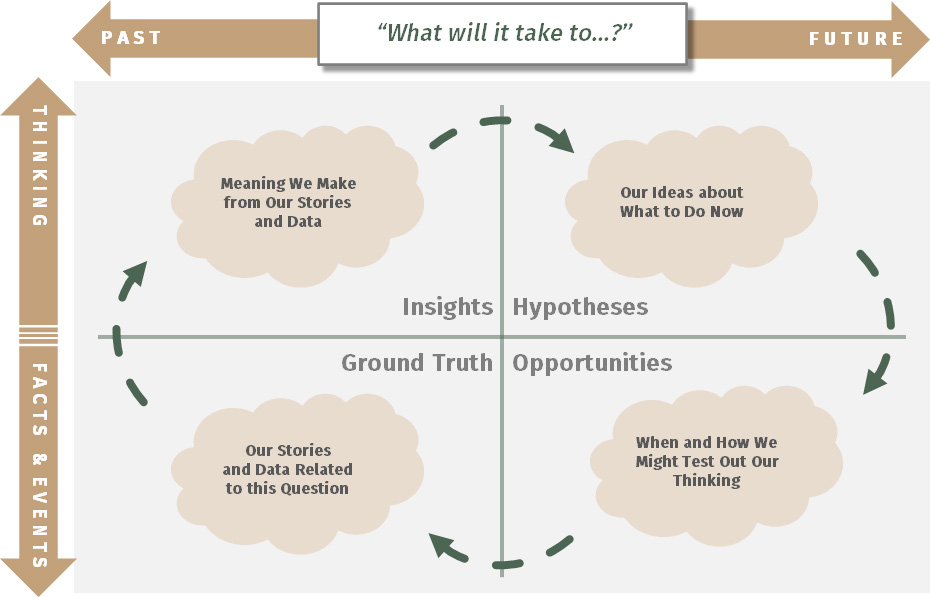What is an EL Table?
EL Tables make it possible for people from within or across groups to come together around a shared question to ask, “What do we know so far?” about a forward-focused, action-oriented question.
Whether on a piece of paper, on the wall, or on a shared online document, at its simplest, an EL Table is two intersecting lines with a question at the top.
The vertical line represents today; to the left of the line is the past; to the right of the line is the future. The horizontal line represents a conscious attempt to separate (but link) thinking and action. Below the line are data we have collected and/or actions we have taken and will take. Above the line is the meaning we make from those past actions and data — our thinking about them, and our thinking about what will make us successful in future action.

The structure of an EL Table is simple, but using it well is an art. We strongly recommend working with a trained EL practitioner to learn how to apply this practice to your own goals and challenges.
EL Tables can be used to facilitate a learning conversation grounded in data and experience. They help us slow down our thinking process and make it explicit. They help people who get stuck in thinking abstractly to tie thinking to action. Likewise, they help people who jump right to solving problems or taking action take time to reflect on the thinking behind their impulse.
When would we use an EL Table?
EL Tables bring a group together around a shared question, to reflect on a set of past experiences, data or research findings, learn together from these past events, and apply what they learn to opportunities coming up in their various calendars. They do not require everyone to align around a single solution. In fact, they are designed to maintain agency and encourage innovation — to ensure that each person or team can discover the ideas that are most relevant to them and plan to test those ideas out in their own work. Use EL Tables to:
- Launch a new initiative
- Compare notes across organizations or geographies about what has worked or not worked around tackling thorny social challenges
- Reflect at the end of an initiative and draw lessons for the next piece of work or to inform the field
- Design conference sessions (or entire convenings) to maximize the collective knowledge in the room
EL Table conversations may be as short as an hour or as long as several days. They can be used by two people or large groups. They can be used over time to capture data from a range of sources and support continuing reflection and experimentation. The World Bank posted a huge banner: “What will it take to end poverty in a generation?” and invited anyone who walked by to write on a card and post it on a wall in the main lobby.
The Basics: How to participate in an EL Table conversation
A key principle to remember in an EL Table conversation is that we are “Experts in Equal Measure”. The goal of an EL Table conversation is not to advocate for your own point of view, but to expand everyone’s thinking. What makes an EL Table conversation powerful is when we all are willing to bring our own experience ‘to the table’ — successes, failures, bumps in the road, and a willingness to be curious about other data or experiences that are similar, different or surprising. The bumps and bruises sometimes hold the most important lessons about what it takes to achieve a goal. If you are asked to do prep work before the session — to read a report or prepare a story to share, please do it. The quality of the conversation will be directly proportional to your readiness to contribute.
Before coming to an EL Table conversation, be sure to look in your own calendar for a real, concrete opportunity where you could apply some interesting idea that you learn from the conversation.
Another principle to remember is that an EL Table invites diverse voices to the table. The experience of the new intern can sometimes move everyone’s thinking forward as much as that of the most senior team members. During the session, be mindful to ensure that all voices get heard and all experiences are respected. Listen especially for counter-examples — e.g., where someone tried the same approach and got a wildly different result. What was different and what can we learn from that? Recognize that people may see the same experiences differently and take different lessons away from them.
It’s not about the quadrants
We can hold a conversation informed by the idea of an EL Table without ever drawing a single line. EL Table conversations are about slowing down. They are about asking a question that matters and telling our stories to each other. They are about remembering to separate the facts from the meaning we make about those facts. They are about spending as much time thinking about the future as we do thinking about the past. And they are about remembering that the conversation isn’t finished until we find some time and space to test out the ideas that emerge from it.
This brief introduction to EL Tables will help you prepare to participate fully in the conversation.